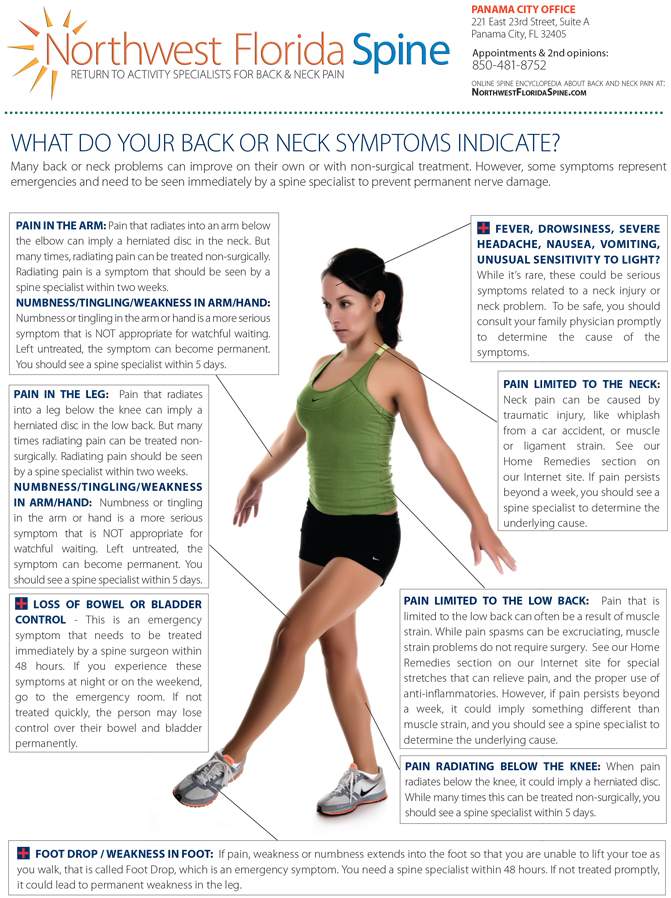 New Coflex device stabilizes vertebrae after stenosis surgery
New Coflex device stabilizes vertebrae after stenosis surgery
Northwest Florida Spine is one of few spine centers in the Florida Gulf Coast proficient in the use of the Coflex stabilization implant. The Coflex device is a motion-preserving titanium implant designed to stabilize the vertebrae after a herniated disc is removed. The implant improves the outcomes from stenosis surgery, with better pain relief and prevention of future issues that would otherwise arise from traditional surgery to relieve the symptoms from stenosis.
What is spinal stenosis?
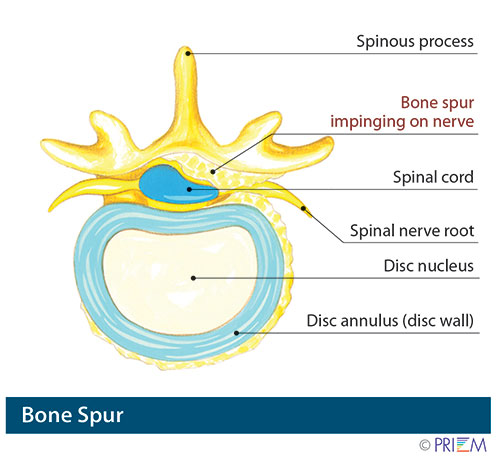 Stenosis is a narrowing of the spinal canal, sometimes caused by a bone spur that encroaches on the spinal cord, the main nerve pathway through the body. Stenosis usually affects people as they age, beyond age 50. Stenosis and its related symptoms can be a common ailment for those in their 60s and 70s. Arthritis can be a contributing factor.
Stenosis is a narrowing of the spinal canal, sometimes caused by a bone spur that encroaches on the spinal cord, the main nerve pathway through the body. Stenosis usually affects people as they age, beyond age 50. Stenosis and its related symptoms can be a common ailment for those in their 60s and 70s. Arthritis can be a contributing factor.
The spinal cord passes through an opening in the vertebrae. Over time, bone spurs can develop that encroach on this spinal canal. Stenosis, either in the low back area or neck, can develop slowly over time. Symptoms can come and go and can be worsened from certain activities that can cause inflammation of the nerve roots branching off from the spinal cord.
One way of explaining how stenosis occurs is to consider how a ring on a finger typically has no painful aspect, until the finger is bruised causing inflammation. The ring then can pose a serious danger to circulation and must be removed. Similarly, when an activity causing irritation or inflammation, or when a bone spur progresses to the point that it acts like a tight ring on a finger, treatment is necessary.
How stenosis is diagnosed
- Doctor visit, medical history & physical examination: The physician looks for limitation of movement and looks for pain or weakness when the patient arches their spine backwards.
- X ray: X-rays only show bone, not soft tissue or nerves. But they can reveal a narrowing of the disc space and the presence of a narrow spinal canal.
- MRI: An MRI can reveal the spinal cord, nerve roots and the spinal canal.
- Myelogram: In some cases, a doctor may order a myelogram where a liquid dye circulates around the spinal cord and spinal nerves which can reveal and confirm pressure on the spinal cord or nerves from either a herniated disc, tumor or bone spur.
- Bone scan: A radioactive material is injected that reveals where bone is actively breaking down or being formed.
In all cases, the purpose of all diagnostic tests is to document the need for surgery, and provide crucial information to the surgeon about which disc level in the back or neck is causing the symptoms.
Treatment for spinal stenosis
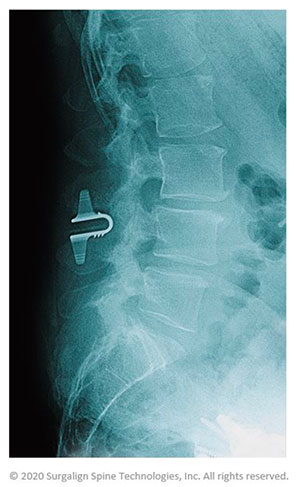 Non-surgical treatment of stenosis can include special physical therapy exercises that limit extension and instead emphasive forward flexion of the back and neck. The therapist also can suggest short-term solutions that may relieve the effects of an attack of stenosis, such as using a recliner rather than a straight back chair to encourage forward flexion. Sometimes chiropractic or acupuncture may be tried as a non-surgical treatment option. Other times, spinal injections can be used to reduce inflammation and the symptoms from the narrowing of the spinal canal. Symptoms can return, however.
Non-surgical treatment of stenosis can include special physical therapy exercises that limit extension and instead emphasive forward flexion of the back and neck. The therapist also can suggest short-term solutions that may relieve the effects of an attack of stenosis, such as using a recliner rather than a straight back chair to encourage forward flexion. Sometimes chiropractic or acupuncture may be tried as a non-surgical treatment option. Other times, spinal injections can be used to reduce inflammation and the symptoms from the narrowing of the spinal canal. Symptoms can return, however.
Longer term, the more permanent solution to spinal stenosis is surgery that removes a bone spur and widens the spinal canal to a normal size that doesn’t encroach on the spinal cord.
Activities for a person in their 50s or 60s that can worsen spinal stenosis include standing or walking for a long period of time, or holding the head in an extended position while biking or swimming. Those in their 60s, for example, should avoid extension exercises (where the back or neck is arched backward) unless recommended by their spine therapist.
Conversely, things that may relieve some symptoms of simple stenosis include lying down or putting the back or neck in a slight flexion position (bent forward).
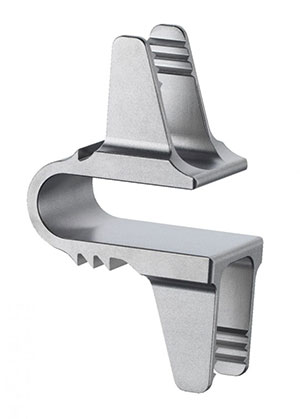 The symptoms of spinal stenosis include:
The symptoms of spinal stenosis include:
- radiating pain into a leg or arm
- tingling into a leg or arm
More serious “emergency symptoms” that need to be seen within a week to prevent the symptoms from becoming permanent are:
- numbness or weakness in a leg or arm
- loss of control of the bowel or bladder
Surgery to relieve symptoms of stenosis
When surgery is necessary, the spine surgeon typically performs a decompressive laminectomy which removes the problematic vertebral bone at the specific level causing the problem. This surgery enlarges the spinal canal back to normal and relieves the symptoms.
How the new Coflex implant improves outcomes from stenosis surgery
The Coflex device is a motion-preserving titanium implant implanted in the low back after lumbar spinal stenosis surgery. After your surgeon performs a direct decompression that removes bone, facet, ligament and/or disc segments from the narrowing in the spinal canal, the spine can become unstable. The traditional way this instability is addressed is with a spinal fusion, where a bone graft is inserted and ultimately fused to the vertebrae above and below. However, locking the vertebrae can sometimes put additional pressure on the remaining disc levels, potentially causing other disc herniations.
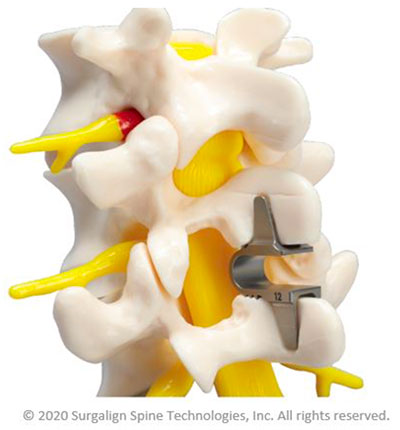 The Coflex implant is designed to keep the spine stable while maintaining normal height and motion in your spine. This new implant reduces the stress on the other disc levels. The Coflex implant procedure includes the following steps.
The Coflex implant is designed to keep the spine stable while maintaining normal height and motion in your spine. This new implant reduces the stress on the other disc levels. The Coflex implant procedure includes the following steps.
- After a microsurgical direct decompression, the motion-preserving device is implanted through a minimal incision and is placed on the lamina (the strongest posterior bone in the spine) to keep your spine stable
- This placement off-loads facet joints, maintaining the height between your bones for nerves to exit freely
- Leg pain and back pain are relieved both short-term and long-term*
- Motion is maintained in both the treated area as well as the spine segment above the device
The Coflex implant provides the following benefits to the stenosis patient:
- Less time in the operating room
- Less blood loss
- Fewer days in the hospital
- Faster relief of pain symptoms and quicker recovery
The Coflex device is the first and only lumbar motion preservation device with clinical data from two prospective randomized studies against two treatment options (decompression alone and decompression with fusion) across two countries (U.S. and Germany). It has been implanted in more than 175,000 patients in over 60 countries worldwide. The studies show that when a patient has only decompression surgery without the use of Coflex, the patient is twice as likely to need either another surgery or a pain-relieving injection.
The design of the Coflex device when implanted after stenosis surgery off-loads weight from the facet joints that would otherwise cause leg and back pain symptoms. The Coflex device helps the vertebrae move in a controlled manner. Patients who suffer from both leg and/or back pain caused by lumbar spinal stenosis are candidates for interlaminar stabilization with the Coflex device.
The coflex device is performed through a small incision in the low back that allows for a minimally invasive approach for treating lumbar spinal stenosis.
Home Remedy Book

As a community service, Northwest Florida Spine mails out a free 36-page Home Remedy Book with customized stretches that can relieve some back and neck pain symptoms. Enter your name and address and we will mail you a copy.
Back to Life Journal

Download our free 16-page Back to Life Journal that shows how to get back to golf, tennis, hiking and more with home remedies. Insert your email to subscribe and download.
Symptoms Chart
Some symptoms can become permanent if you don’t see the physician with in 24 hours. Find out when you can use “watchful waiting” and when you have an emergency symptom.
Exercise Library

What do exercises have to do with relieving pain? Research in sports medicine and spine care exercises have shown to help relieve joint, ligament, muscle problems in the legs, arms, neck and back and increase range of motion.
Need an Appointment?
Dr. Michael Rohan, Jr. is a board certified orthopedic surgeon who is fellowship-trained in spine surgery, the highest level of medical education in the U.S. For over 10 years, Dr. Michael Rohan, Jr. had a prominent spine center on the Florida Gulf Coast with offices in Panama City and Destin before expanding his practice with a new spine care location in Middleburg in Clay County, Florida, a suburb of Jacksonville in Northern Florida. The Jacksonville practice location is convenient to patients from other cities like St. Augustine, Gainesville, Palm Coast, Daytona Beach, and Duval County. Other patients travel from South Georgia cities like Brunswick, GA; Waycross, GA; and coastal locations like Jekyll Island and Savannah. If you’ve been told you need spine surgery, it can be beneficial to get a second opinion for spine surgery from a spine surgeon who specializes in minimally invasive spine surgery and artificial disc replacement.
Disclaimer: Internet Explorer is now obsolete and has been replaced by Microsoft. If you are viewing in Internet Explorer 8 or older, you will need to update your browser by Clicking here.

